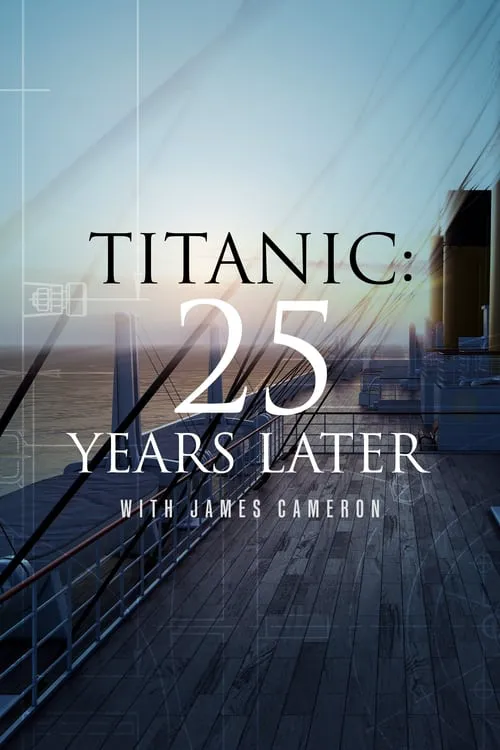Titanic: 25 Years Later with James Cameron

Intrigue
In the film "Titanic: 25 Years Later with James Cameron," the renowned director returns to the legendary story of one of the greatest maritime disasters in history, but this time with a new perspective and a fresh mission. Two and a half decades have passed since the tragic events of the RMS Titanic's ill-fated maiden voyage, and while the memories of that catastrophic night continue to haunt the world, James Cameron has been driven by one burning question: could Jack Dawson and Rose DeWitt Bukater have both survived the freezing waters of the North Atlantic on the ill-fated ship's wooden lifeboat? The idea has been a contentious topic among fans and historians alike since the film's initial release in 1997. Many have argued that Jack, played by Leonardo DiCaprio, could have been saved if only he had been able to climb aboard the wooden lifeboat, allowing him and Rose, played by Kate Winslet, to survive together. The debate has sparked heated discussions, theories, and even conspiracy theories, with some claiming that the film was manipulated or that there were unseen forces at play that night. James Cameron, determined to settle the debate once and for all, sets out on a mission to recreate the events of that fateful night and to conduct rigorous experiments to test the theory that both Jack and Rose could have fit on the precarious wooden lifeboat. He surrounds himself with a team of experts, including engineers, physicists, and historians, to help him design and execute a series of tests and simulations that will provide conclusive evidence. The film takes the audience on a journey with James Cameron as he delves into the world of Titanic research and re-exploration. He visits museums and archives, speaking with experts and individuals who have dedicated their lives to studying the Titanic's history. He also travels to the wreck site, where he joins the team of Deepsea Challenger, a submersible vessel that has been designed to explore the depths of the ocean. As Cameron and his team conduct their experiments and simulations, they carefully recreate the conditions of that night, taking into account the freezing temperatures, the limited space on the lifeboat, and the physical and mental limitations of Jack and Rose. They use advanced computer simulations and physical models to test the lifeboat's capacity, the behavior of humans in extreme cold, and the physics of floating objects in water. The team's findings, which are presented in the film, are nothing short of astonishing. They reveal that, under the right conditions, both Jack and Rose could have indeed fit on the lifeboat, but only if they had made certain adjustments and concessions. Cameron's team demonstrates that the lifeboat was larger than initially thought, and that with some adjustments to its buoyancy and stability, it could have accommodated two adults, albeit in a rather cramped and awkward position. However, as Cameron's investigation unfolds, it becomes clear that there are other factors at play that make the situation far more complex. He discovers that the temperature and humidity in the air on that night were not as extreme as initially believed, which would have affected the rate at which they would have succumbed to hypothermia. He also reveals that the lifeboat's crew had access to equipment and supplies that could have been used to keep the pair warm and comfortable, had they chosen to do so. As the narrative unfolds, the debate around the fate of Jack and Rose becomes increasingly nuanced. The line between fact and fiction blurred, and the public's perception of what really happened on the Titanic's ill-fated night is forever changed. The film challenges the audience to confront their own biases, preconceptions, and assumptions, forcing them to consider the intricacies and complexities of the situation. Ultimately, the film raises more questions than it answers, and James Cameron leaves the audience to ponder the true nature of fate, coincidence, and the human condition. He asks us to consider: what if? What if Jack and Rose had made it out alive? What if they had been given a second chance? The possibilities are endless, and the debate will undoubtedly continue, but for now, the story of the Titanic, Jack, and Rose will forever be tied to the quest for knowledge and the pursuit of the truth. As the film concludes, James Cameron's voiceover echoes in the background, reflecting on the nature of the debate and the enduring legacy of the Titanic. He remarks, "The story of the Titanic is not just about a ship and its passengers; it's about the human experience. It's about the capacity for hope, for love, and for survival in the face of adversity. The real mystery of the Titanic is not just what happened on that fateful night, but what it reveals about ourselves." As the credits roll, the audience is left to ponder the implications of Cameron's conclusion, forever changed by the experience of witnessing the Titanic's story unfold in a new and unexpected way.
Critiques
Recommandations




